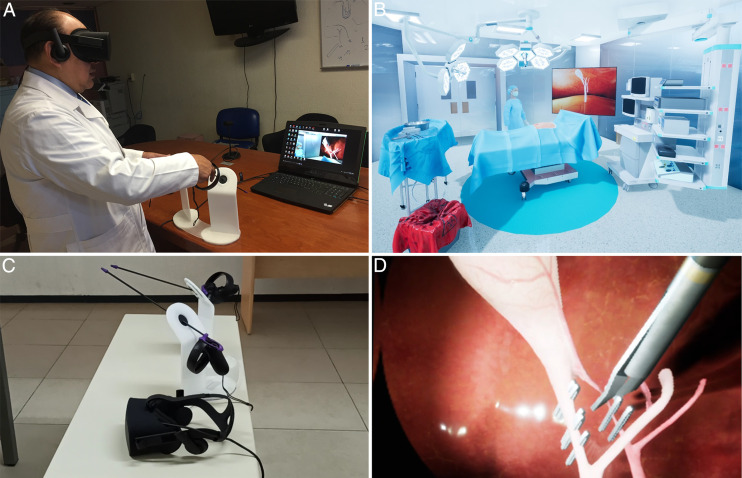To the Editor,
Amidst the pandemic of COVID-19, the surgical education of residents in training has undergone significant changes due to the introduction of social distancing measures that prevent the spread of this new disease. The Mexican Academy of Surgery (AMC) has recommended that hospitals in Mexico postpone or cancel elective surgeries so as not to overload their capacity and focus their efforts on Intensive Care Units and critical patients. These restrictions have affected the standard surgical training of residents and limited their exposure to surgeries after rotation in hospitals was restructured.
Surgical simulation using virtual reality is a useful tool for resident skill training in Minimally Invasive Surgery techniques. These simulators can improve surgical psychomotor skills and reduce surgeons’ errors in the operating room without requiring personal protective equipment during training, allocating these resources instead to the sectors that currently need it.
Recent advances in this technology include the development of new immersive applications in surgery scenarios, which reproduce the environment and distractions of real operating rooms. GEN2-VR©1 is an immersive virtual reality laparoscopic simulator that reproduces a virtual operating room using a VR2000 head-mounted display (HMD) (Virtual Realities Inc) and VBLaST-PT©2 to interact with a virtual patient. The simulator creates distractions and interruptions common during surgical training. Huber et al3,4 developed a customizable and immersive virtual reality simulator, based on the LapSim simulator (Surgical Science, Gothenburg, Sweden) in combination with HMD HTC Vive 2016 technology (High Tech Computer Corp, Taoyuan, Taiwan). The 360° virtual setting was developed using equipment from a real operating room, where the virtual application of the LapSim simulator is integrated. The virtual operating room simulation setup5 is another immersive simulator, which consisted of 3 components: (1) a LapMentor III laparoscopic simulator (Simbionix™, 3D Systems Corporation, USA), (2) an HMD VR Oculus Rift 2016 with enabled stereoscopic imaging and integrated audio, and (3) a 360° virtual reality scenario developed from a real operating room, including complete surgical equipment, instruments and a virtual patient.
In collaboration with pediatric surgeons from Hospital Infantil de México Federico Gómez, we have developed an immersive and customizable virtual reality simulator for laparoscopic procedures training of pediatric surgical residents. The virtual immersive operating room simulators (VIORS) simulator uses only the HMD VR Oculus Rift 2016 system and a VR application to provide pediatric surgical residents with the experience of interacting in a simulated operating room, including distracters and sounds (Figure 1A). The application consists of a 360° virtual operating room, roughly the size of the EndoSuite in the hospital, developed with the game engine Unreal Engine 4, with a surgical assistant, a laparoscopic tower, an anesthesia unit, and a virtual patient (Figure 1B). Residents put on the Oculus Rift headset and use the modified Oculus Touch controls with 3D printed parts to interact with laparoscopic instruments in an acrylic support, which simulates the laparoscopic configuration and the position of the trocars (Figure 1C). The training task consists of a laparoscopic cholecystectomy on a virtual patient; the trainee places clips on the cystic duct and artery, cuts, and removes the gallbladder (Figure 1D).
Figure 1.
Virtual immersive operating room simulator. (A) External view of portable and customizable virtual reality laparoscopic simulator prototype, (B) personal view of the surgeon in the virtual operating room surrounding, (C) acrylic support for the position of trocars and modified controls with 3D printing parts, and (D) training task of application of clips in the virtual laparoscopic cholecystectomy procedure on the gallbladder.
In this COVID-19 public health crisis, the VIORS simulator offers a portable solution for the training of psychomotor and cognitive skills in laparoscopic surgical procedures. The simulator provides immersion in a virtual operating room, according to residency educational needs and respecting social distancing measures.
Acknowledgments
This work has been carried out with the support of the UNAM - DGAPA - PAPIME program, project number PE217020.
Author Contributions
Study concept and design: Fernando Pérez-Escamirosa, Eduardo Alfredo Ruíz-Vereo, David Medina-Alvarez
Acquisition of data: David Medina-Alvarez, Eduardo Alfredo Ruíz-Vereo, Ricardo Manuel Ordorica-Flores, Fernando Pérez-Escamirosa
Analysis and interpretation: Fernando Pérez-Escamirosa, Arturo Minor-Martínez, Jesús Tapia-Jurado
Study supervision: Ricardo Manuel Ordorica-Flores, Arturo Minor-Martínez, Jesús Tapia-Jurado, Fernando Pérez-Escamirosa
Declaration of Conflicting Interests
The authors declared no potential conflicts of interest with respect to the research, authorship, and/or publication of this article.
Funding
The authors received no financial support for the research, authorship, and/or publication of this article.
ORCID iD
Fernando Pérez-Escamirosa https://orcid.org/0000-0001-7886-8692
References
- 1.Sankaranarayanan G, Li B, Manser K, et al. Face and construct validation of a next generation virtual reality (Gen2-VR) surgical simulator. Surg Endosc. 2016;30(3):979-985. doi: 10.1007/s00464-015-4278-7 [DOI] [PMC free article] [PubMed] [Google Scholar]
- 2.Arikatla VS, Ahn W, Sankaranarayanan G, De S. Towards virtual FLS: Development of a peg transfer simulator. Int J Med Robot Comput Assist Surg. 2014;10(3):344-355. doi: 10.1002/rcs.1534 [DOI] [PMC free article] [PubMed] [Google Scholar]
- 3.Huber T, Wunderling T, Paschold M, Lang H, Kneist W, Hansen C. Highly immersive virtual reality laparoscopy simulation: Development and future aspects. Int J Comput Assist Radiol Surg. 2018;13(2):281-290. doi: 10.1007/s11548-017-1686-2 [DOI] [PubMed] [Google Scholar]
- 4.Huber T, Paschold M, Hansen C, Lang H, Kneist W. Artificial versus video-based immersive virtual surroundings: Analysis of performance and user’s Preference. Surg Innovat. 2018;25(3):280-285. doi: 10.1177/1553350618761756 [DOI] [PubMed] [Google Scholar]
- 5.Ganni S, Li M, Botden SMBI, et al. Virtual operating room simulation setup (VORSS) for procedural training in minimally invasive surgery–A pilot study. Indian J Surg. 2020. Advance online publication. doi: 10.1007/s12262-020-02131-z 10.1007/s12262-020-02131-z [DOI] [Google Scholar]



